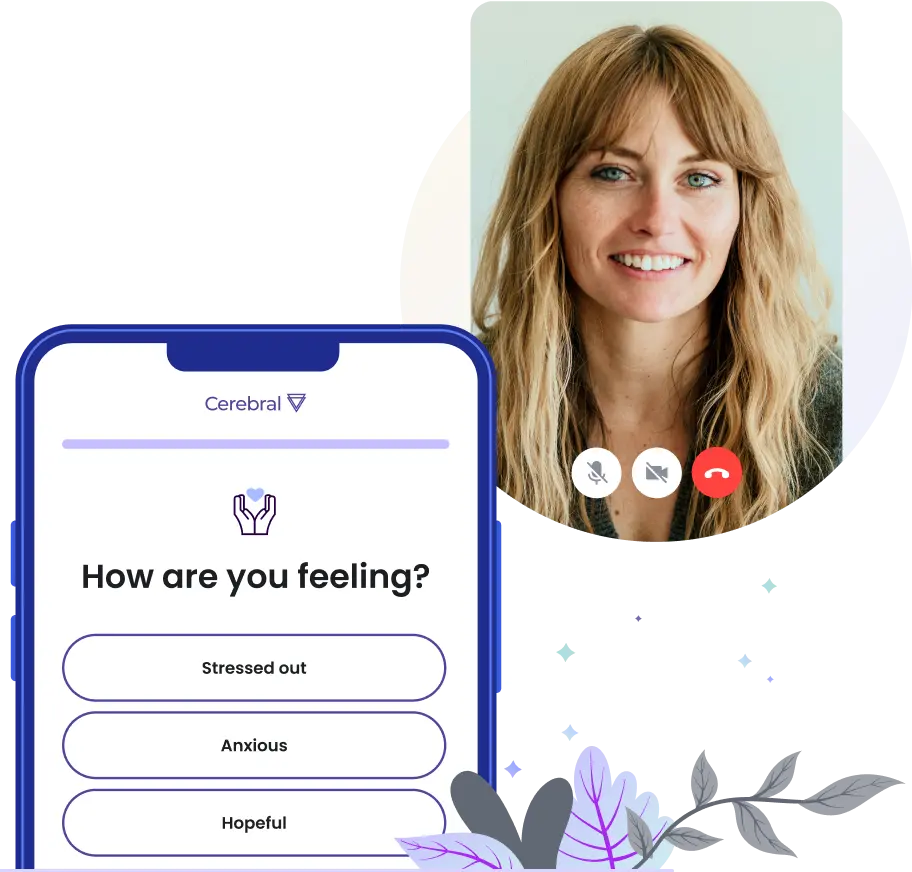For those who have never experienced it, the phrase 'manic episode' might conjure up images of someone who is simply joyful or hyper. However, the reality of this symptom of bipolar disorder — which is often mischaracterized or misunderstood — is more complex.
For individuals with bipolar disorder, a manic episode can be an intense, all-consuming experience that fluctuates between euphoria and dread. It's a rollercoaster of emotions and behaviors that can significantly impact every aspect of their lives.
If you're seeking to understand or support someone with bipolar disorder, or if you suspect that you or a loved one is experiencing these symptoms, it's crucial to comprehend the nuances of a manic episode.
Here, we'll walk through what manic episodes might involve, what can trigger them, how to distinguish between the different levels of mania, and what mental health resources can help.
Here’s what bipolar patients describe
Bipolar patients describe a manic episode as an emotional storm, characterized by intense and sometimes extreme feelings. At its most elevated state, it can involve a sensation of grandiosity, where the individual may:
- Feel invincible
- Have unrealistic beliefs about their abilities or financial state
- Engage in reckless behaviors
Mixed with this feeling of extreme self-confidence, self-importance, superiority, and grandeur is often an increased level of irritability and a persistent non-need for sleep. The individual might feel physically unable to stay still or relax.
Some patients describe it as a force that is both unstoppable and overwhelming.
Why this is important: A manic episode is much more than feeling a bit too energetic; it's a profound shift in mood that can impact judgment and behavior in significant ways.
Understanding what a bipolar manic episode feels like is one step closer to understanding the entire bipolar experience.
What can trigger a manic episode
Several factors can trigger a manic episode for individuals with bipolar disorder. Some of these include:
Sleep disruptions
A consistent lack of sleep or sudden changes in sleep patterns can be a major trigger. It's not just about the hours — quality and regularity of sleep matter, too.
In terms of sleep's role in triggering a manic episode, the impact can be profound and relatively quick. Individuals with bipolar disorder might begin to experience the onset of manic symptoms after just a few nights of significantly reduced sleep.
Be careful: For some, even missing a single night's sleep can lead to noticeable changes in mood and energy levels, pushing them closer to mania.
Studies suggest that prolonged periods of sleep disruption — such as those experienced during night shifts at work or due to chronic insomnia — can be particularly harmful. These scenarios increase the risk of a manic episode, highlighting the intricate link between sleep patterns and mood regulation in individuals with bipolar disorder.
As a first step, we have a helpful resource on how to promote good sleep habits in your daily life. When seeking bipolar treatment, this can also be addressed.
Stressful life events
Highly stressful events, such as the loss of a loved one, job changes, or relationship issues, often act as catalysts for a manic episode. These situations can cause significant emotional upheaval, forcing an individual's system into overdrive and potentially leading to mania.
Even if a significant life change is a positive thing, it can sometimes lead to an episode, too.
Substance abuse
The use of alcohol, drugs, or even the misuse of prescription medication can significantly disrupt the brain's chemistry. This interference can trigger manic episodes, as individuals with bipolar disorder can be more susceptible to these changes. Alcohol or drug use can also lead to heightened mania or rapid cycling.
Changes in medication or treatment plans
Sometimes, sudden or significant dosage adjustments in medication or changes in treatment can inadvertently spark a manic episode by disrupting the delicate balance that keeps symptoms in check. This could be due to the body's reaction to new medications, the cessation of a medication, or a negative interaction between different medications.
It’s worth noting: Sometimes you could be taking good care of yourself and actively participating in treatment, and you still could experience a manic episode. It's important to keep in mind that managing conditions like bipolar disorder is a continuous process.
How long do manic episodes last?
The duration of a manic episode can vary greatly from person to person. On average, an episode can last for several weeks or even months if left untreated. However, some individuals may experience shorter episodes while others may cycle between mania and depression in rapid succession, known as rapid cycling.
The length and intensity of each manic episode are unique to the individual and depend on various factors, including bipolar treatment adherence and environmental influences.
If you’re experiencing one, it's essential to monitor and track your symptoms to determine its length and severity. This information can help you develop an effective treatment plan with your mental healthcare provider.
Helpful tools: You can use this mood tracker and/or symptom tracker from the Depression and Bipolar Support Alliance to easily document your feelings and experiences.
Friends, family, and those supporting an individual with bipolar disorder need to remember to be patient, as it can take time for the symptoms of mania to subside.
Signs & symptoms of mania
Recognizing the signs and symptoms of a manic episode is crucial for early intervention and management. Here are some common features:
- Exhibiting extremely high levels of energy: People in a manic state may seem to be in perpetual motion, unable to sit still, and may jump from one activity to another.
- Experiencing racing thoughts: Mania can be characterized by a rapid, disjointed thought process that can make concentration difficult and lead to impulsivity.
- Changing speech patterns: A person may speak rapidly and incessantly, sometimes even to the point of incoherence. They may also interrupt others more and have a shorter temper.
- Not needing to rest: A reduced need for sleep is a hallmark of mania, as one may feel confident that they can function fully on limited or no sleep.
- Engaging in risky and impulsive behaviors: Manic individuals often behave in ways they wouldn’t ordinarily consider, such as excessively spending, gambling, participating in risky sexual behaviors, and abusing substances.
- Experiencing psychosis: In severe cases, mania can lead to a break from reality, which can present as hallucinations and/or delusions.
The importance of recognizing the triggers and symptoms
A manic episode is much more complex than simply being in a good mood or feeling high energy levels. It involves intense and sometimes extreme emotions, behaviors, and thought patterns that dramatically impact daily life.
By understanding the triggers and characteristics of a manic episode, individuals with bipolar disorder and their loved ones can better recognize and manage the symptoms.
Why this is important: Seeking professional help is crucial in managing bipolar disorder, as it is a lifelong condition that requires proper treatment and support.
With the right mental health resources and understanding, individuals with bipolar disorder can learn to navigate manic episodes to lead a more stable and fulfilling life.
Hypomania vs. mania
Hypomania is often described as a ‘lesser’ form of mania. While the symptoms — increased energy, decreased need for sleep, and racing thoughts — are similar to those of mania, they are less extreme.
People in a hypomanic state can often function at a higher level than normal and may even find it to be a productive or enjoyable experience.

Coming down from a manic episode
The end of a manic episode can be as distressing as the episode itself. Sudden transitions from intense energy and productivity to normalcy or depression are jarring.
This comedown phase — called the 'crash' — is marked by a drastic change in mood. The heightened self-esteem and self-importance associated with mania can give way to deep feelings of guilt and despair.
It’s at this vulnerable time that individuals are most at risk for suicide or self-harm and, therefore, require close observation and support.
If you or someone you know is thinking about acting on suicidal thoughts, reach out for help immediately.
- Call 911 if you’re having a mental health emergency.
- Text HOME to 741-741 if you're emotionally distressed and need immediate support.
- Call 988 for the National Suicide Prevention Hotline.
Use this resource to become prepared: Addressing Suicidal Thoughts: A Manual for Suicide Prevention
Common misconceptions about mania
Misconceptions about bipolar disorder and mania can lead to stigma and undermine the real challenges faced by those with the condition.
It’s always a euphoric experience
While euphoria can be a part of it, many people experience irritability, agitation, and a sense of 'mixed mania,' which combines features of mania with symptoms of depression.
Depression and mania can’t be experienced together
Many people with bipolar disorder experience mixed episodes, where symptoms of both mania and depression coincide. This can be a particularly dangerous time for individuals, as they may have the energy of mania but the negative thoughts and ideations from depression.
Why understanding the truth matters: By acknowledging the realities of bipolar disorder, we can create a more empathetic and informed community that’s better equipped to provide the understanding and mental health resources needed to support those with this condition.
Bipolar mental health resources
If you or someone close to you is dealing with bipolar disorder, seeking assistance is a crucial step toward well-being. Managing bipolar symptoms requires comprehensive support systems and professional interventions, including:
- Professional therapy, which provides a structured environment to discuss experiences and develop strategies for managing episodes.
- Medication management is vital, as it can stabilize mood and prevent episodes from becoming more severe.
- Support groups, whether online or in-person, create a community of understanding and shared experiences, offering comfort and practical advice.
- Emergency psychiatric services or a crisis hotline may be needed in cases where symptoms escalate quickly.
Effective treatment typically involves a dual approach: medication to stabilize mood swings and psychotherapy, which may include talk therapy, cognitive behavioral therapy (CBT), and other behavioral therapies.
Bipolar treatment is effective: According to the National Advisory Mental Health Council, the treatment success rate is a noteworthy 80% for bipolar disorder.
We offer a convenient solution, providing an online evaluation for bipolar I and bipolar II, medication prescriptions for treatment if indicated and accepted, and delivering access to trained therapists and care counselors for cognitive behavioral interventions.
With Cerebral, you can get both forms of treatment from one resource — all without ever having to leave home.
We recognize that an essential aspect of managing bipolar disorder involves establishing a consistent daily routine. This includes strategies for building healthy habits like eating a balanced diet, regularly exercising, and getting good sleep. It’s really important to take your medication as agreed to manage your condition. If you're on medication, make sure to talk openly with your care team if you have any concerns or questions.
We know that getting help for bipolar disorder can feel overwhelming, both in practical terms and financially. At Cerebral, we're committed to making quality care more accessible and affordable.

How to Support a Loved One with Bipolar Disorder

Bipolar vs. BPD: How To Tell The Difference

9 Common Triggers for Bipolar Episodes

Call 911 if you’re having a
mental health emergency
Text Home to 741-741 if you're in emotional
distress and need immediate support
Call or text 988 Suicide &
Crisis Lifeline. Chat service
is available at 988lifeline.org.